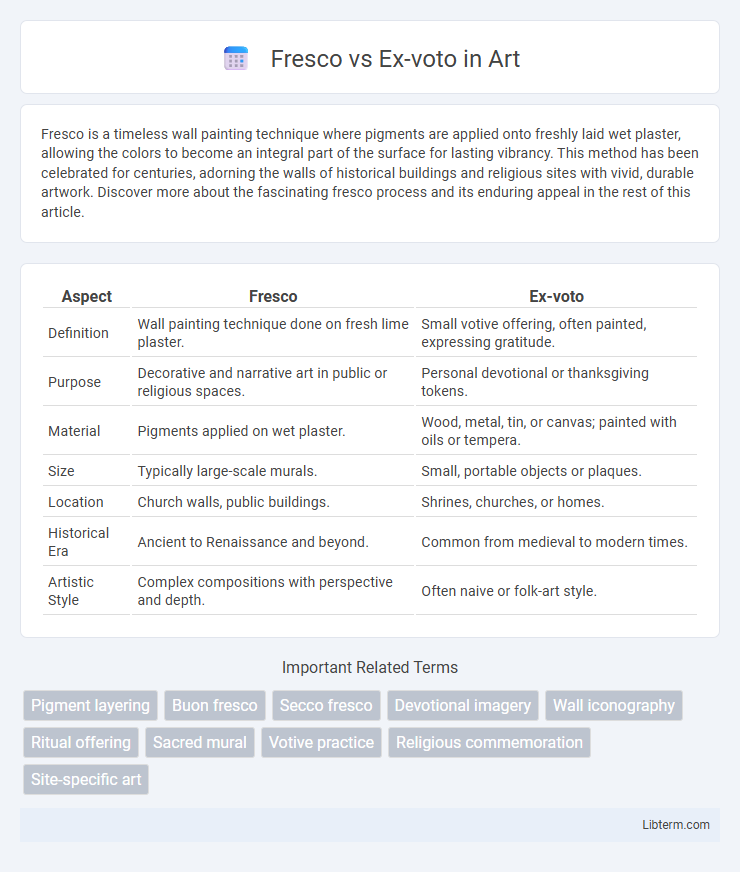Fresco is a timeless wall painting technique where pigments are applied onto freshly laid wet plaster, allowing the colors to become an integral part of the surface for lasting vibrancy. This method has been celebrated for centuries, adorning the walls of historical buildings and religious sites with vivid, durable artwork. Discover more about the fascinating fresco process and its enduring appeal in the rest of this article.
Table of Comparison
| Aspect | Fresco | Ex-voto |
|---|---|---|
| Definition | Wall painting technique done on fresh lime plaster. | Small votive offering, often painted, expressing gratitude. |
| Purpose | Decorative and narrative art in public or religious spaces. | Personal devotional or thanksgiving tokens. |
| Material | Pigments applied on wet plaster. | Wood, metal, tin, or canvas; painted with oils or tempera. |
| Size | Typically large-scale murals. | Small, portable objects or plaques. |
| Location | Church walls, public buildings. | Shrines, churches, or homes. |
| Historical Era | Ancient to Renaissance and beyond. | Common from medieval to modern times. |
| Artistic Style | Complex compositions with perspective and depth. | Often naive or folk-art style. |
Introduction to Fresco and Ex-voto
Fresco is a mural painting technique executed on freshly laid lime plaster, allowing pigments to bond with the wall surface for durability and vivid colors, commonly found in Renaissance and ancient art. Ex-voto refers to votive offerings, often small paintings or objects, given in gratitude or devotion, typically displayed in churches or shrines as expressions of faith or thanksgiving. Both Fresco and Ex-voto serve distinct artistic and cultural roles, with Frescoes embodying large-scale narrative art and Ex-votos representing personal acts of religious piety.
Historical Origins of Fresco Art
Fresco art originated in ancient civilizations such as Minoan Crete and Classical Rome, where pigments were applied onto wet plaster to create durable wall paintings. This technique contrasts with ex-voto paintings, which emerged later as votive offerings expressing gratitude or devotion, typically on wood or canvas. Frescoes' historical significance lies in their integration with architectural structures, preserving cultural and religious narratives over millennia.
The Evolution of Ex-voto Traditions
Ex-voto traditions evolved from early devotional offerings to intricate symbols of gratitude, contrasting with frescoes that primarily depict religious narratives on walls. Ex-votos are tangible tokens often crafted from metal, wood, or canvas to express personal miracles and devotion, while frescoes serve as large-scale visual storytelling mediums within sacred spaces. The shift in ex-voto styles reflects cultural and historical influences, highlighting their role in personalized spiritual expressions across various regions.
Techniques: Fresco Painting Methods vs Ex-voto Creation
Fresco painting techniques involve applying pigments directly onto wet lime plaster, allowing the colors to bind chemically for long-lasting vibrancy and durability, as seen in Renaissance art. Ex-voto creation employs mixed media on various supports such as wood, metal, or canvas, often incorporating symbolic objects, inscriptions, and personal dedications to express gratitude or seek divine intervention. The fresco method demands precise timing and skilled brushwork on freshly prepared surfaces, whereas ex-votos prioritize emotional expression and narrative through diverse materials and folk art styles.
Symbolism in Fresco Artwork
Fresco artwork symbolizes spiritual themes through vibrant, durable pigments applied to wet plaster, creating a permanent connection between the divine and earthly realms. Frescoes often depict biblical narratives, saints, and divine figures with symbolic gestures and iconography that convey theological messages to viewers. The medium's integration with architecture enhances its symbolic function, transforming walls into sacred spaces imbued with religious significance.
Religious Significance of Ex-votos
Ex-votos hold profound religious significance as tangible expressions of gratitude and devotion, often bestowed in fulfillment of vows following divine intervention or answered prayers. These devotional offerings, ranging from paintings to small objects, serve as personal testimonies within sacred spaces, contrasting the public and artistic grandeur of frescoes. Ex-votos embody intimate spiritual narratives, reinforcing faith and communal religious identity through personalized acts of worship and remembrance.
Preservation and Conservation Challenges
Frescoes, created by applying pigment onto wet plaster, face significant preservation challenges due to their vulnerability to moisture, salt efflorescence, and environmental fluctuations that cause plaster to crack or flake. Ex-votos, often painted on wood or metal panels, suffer from organic material degradation, corrosion, and fading pigments, complicating conservation efforts. Both art forms require specialized climate control, careful cleaning, and stabilization techniques to prevent irreversible damage and ensure longevity.
Iconography: Visual Stories in Fresco and Ex-voto
Fresco iconography employs large-scale, narrative murals that depict biblical scenes, saints, and religious events with intricate symbolism and vibrant colors to convey spiritual stories on church walls. Ex-voto iconography presents smaller, personal votive paintings or objects that illustrate miracles, answered prayers, or acts of devotion, often including the donor's likeness and specific details of the event. Both art forms use visual storytelling to express faith and devotion but differ in scale, purpose, and direct personal connection within their iconographic elements.
Influence on Contemporary Art and Culture
Fresco techniques have profoundly influenced contemporary muralists by inspiring large-scale, durable artworks that integrate seamlessly with architectural spaces, fostering a resurgence in public art projects and community engagement. Ex-voto paintings, with their deeply personal and devotional narratives, have shaped contemporary art by emphasizing storytelling and emotional authenticity, often reflected in mixed media and outsider art movements. Both traditions contribute to contemporary culture by blending historical religious iconography with modern artistic expressions, enriching visual language and cultural identity.
Conclusion: Comparing Fresco and Ex-voto
Fresco and ex-voto represent distinct artistic expressions with frescoes embodying large-scale, mural paintings integral to architectural spaces, while ex-votos are small, personal votive offerings often created in gratitude for divine intervention. Frescoes emphasize communal and religious storytelling through durable pigments applied on wet plaster, showcasing a blend of artistry and technique intended for long-term preservation. Ex-votos prioritize intimate, individualized devotion, reflecting personal narratives and faith, thus highlighting the contrasts in scale, purpose, and cultural significance between the two forms.
Fresco Infographic

 libterm.com
libterm.com